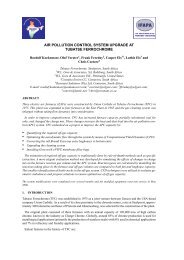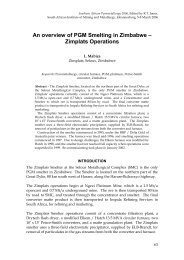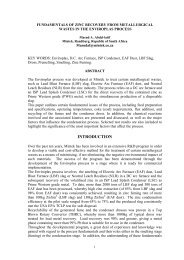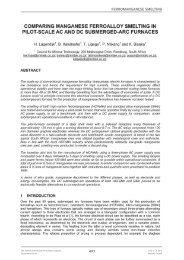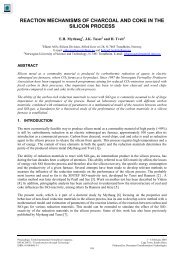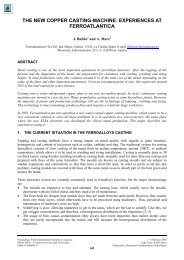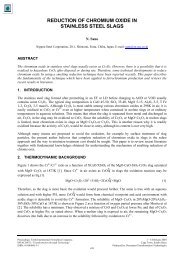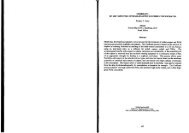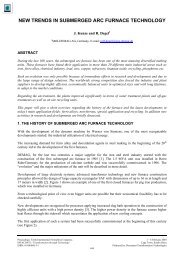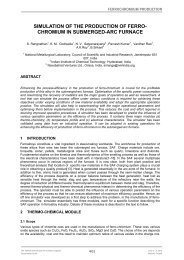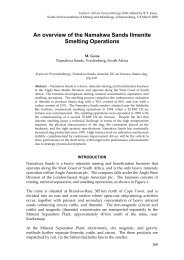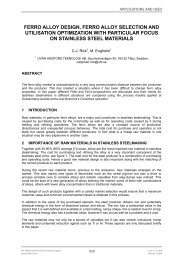the effect of alumina in ferromanganese slag - Pyro.co.za
the effect of alumina in ferromanganese slag - Pyro.co.za
the effect of alumina in ferromanganese slag - Pyro.co.za
You also want an ePaper? Increase the reach of your titles
YUMPU automatically turns print PDFs into web optimized ePapers that Google loves.
The Effect <strong>of</strong> Alum<strong>in</strong>a <strong>in</strong> Ferromanganese Slag 33915001400Liquid Slag(Mn,Ca,Mg)O ssTemperature ( o C)13001200B = 0.8A/S = 1.0A/S = 0.8A/S = 0.6A/S = 0.4110025 30 35 40 45MnO (wt%)Figure 4: Influence <strong>of</strong> A/S ratio on <strong>the</strong> liquidus temperature <strong>of</strong> <strong>the</strong> MnO-SiO 2 -CaO-MgO-Al 2 O 3<strong>ferromanganese</strong> <strong>slag</strong>18001700Liquid <strong>slag</strong>1600Temperature ( o C)15001400130012001100(Mn,Ca,Al,Mg)O ssA/S = 0.5B = 0.4B = 0.6B = 0.8B = 1.0100025 30 35 40 45 50MnO (wt%)Figure 5: Influence <strong>of</strong> basicity on <strong>the</strong> liquidus temperature <strong>of</strong> <strong>the</strong> MnO-SiO 2 -CaO-MgO-Al 2 O 3<strong>ferromanganese</strong> <strong>slag</strong>
340 INFACON XI6042CaO/MgO = 5.6Basicity = 0.4CaO/MgO = 5.6Basicity = 0.85538MnO Eq.(wt%)501450 o C1400 o C1350 o CMnO Eq.(wt%)341450 o C1400 o C1350 o C(a)450.2 0.4 0.6 0.8 1.0A/S ratio(b)300.2 0.4 0.6 0.8 1.0A/S ratioFigure 6: Effect <strong>of</strong> A/S ratio on <strong>the</strong> equilibrium MnO <strong>co</strong>ntent1.00.8SiO 2= 27-28 wt%MgO = 5 wt%1450 o C1350 o C0.6B = 0.8Si (wt%)0.40.2B = 0.40.00.2 0.4 0.6 0.8 1.0A/S ratioFigure 7: Effect <strong>of</strong> A/S ratio on <strong>the</strong> equilibrium sili<strong>co</strong>n <strong>co</strong>ntent
The Effect <strong>of</strong> Alum<strong>in</strong>a <strong>in</strong> Ferromanganese Slag 34110Vis<strong>co</strong>sity (poise)8641450 o CSiO 2+Al 2O 3= 38 wt%CaO/MgO = 5.6A/S = 0.8A/S = 0.6A/S = 0.4200.2 0.4 0.6 0.8 1.0BasicityFigure 8: Effect <strong>of</strong> A/S ratio and basicity on <strong>the</strong> vis<strong>co</strong>sities <strong>of</strong> <strong>ferromanganese</strong> <strong>slag</strong>1.4Vis<strong>co</strong>sity (poise)1.21.0Ferromanganese <strong>slag</strong>:MnO = 40 wt%SiO 2= 25 wt%Al 2O 3= 10 wt%MgO = 7 wt%CaO = 18 wt%0.80.61200 1300 1400 1500Temperature ( o C)Figure 9: Effect <strong>of</strong> temperature on <strong>the</strong> vis<strong>co</strong>sity <strong>of</strong> typical <strong>ferromanganese</strong> <strong>slag</strong>
342 INFACON XIFigure 10: Calculated vis<strong>co</strong>sities along <strong>the</strong> liquidus with fixed A/S ratio and basicity (solid l<strong>in</strong>es). The dottedl<strong>in</strong>es represent <strong>the</strong> <strong>co</strong>rrespond<strong>in</strong>g temperature <strong>in</strong> <strong>the</strong> solid l<strong>in</strong>esAs discussed above, <strong>in</strong>dustrial <strong>ferromanganese</strong> <strong>slag</strong>s have <strong>co</strong>mpositions close to <strong>the</strong> liquidus <strong>co</strong>mposition.Therefore it is <strong>of</strong> practical importance to re<strong>co</strong>gnize vis<strong>co</strong>sities <strong>of</strong> <strong>slag</strong>s at <strong>the</strong>ir liquidus <strong>co</strong>mposition at varioustemperatures. Figure 10: is an example show<strong>in</strong>g <strong>the</strong> vis<strong>co</strong>sity as function <strong>of</strong> liquidus MnO <strong>co</strong>ntent at differenttemperatures. The calculated liquidus temperature vs. MnO <strong>co</strong>ntent relations is shown as dotted l<strong>in</strong>es <strong>in</strong> <strong>the</strong>figure. It is evident that an acid operation tends to <strong>in</strong>crease <strong>the</strong> vis<strong>co</strong>sity <strong>of</strong> “primary liquid <strong>slag</strong>”. This is primarydue to <strong>the</strong> fact that <strong>the</strong> more acid <strong>slag</strong> <strong>co</strong>nta<strong>in</strong>s more SiO 2 . The vis<strong>co</strong>sity <strong>of</strong> pure liquid SiO 2 is severalorders <strong>of</strong> magnitudes higher than that <strong>of</strong> pure <strong>alum<strong>in</strong>a</strong> and o<strong>the</strong>r oxides. Increas<strong>in</strong>g MnO <strong>co</strong>ntent, on one handbreaks <strong>the</strong> 4−SiO 4network and on <strong>the</strong> o<strong>the</strong>r hand <strong>in</strong>creases liquidus temperature, results <strong>in</strong> <strong>the</strong> decrease <strong>in</strong>vis<strong>co</strong>sity <strong>of</strong> liquid <strong>slag</strong>. This shows that <strong>the</strong> vis<strong>co</strong>sity is not “sensitive” to <strong>the</strong> MnO <strong>co</strong>ntent.5. CONCLUSIONSThe <strong>in</strong>fluence <strong>of</strong> <strong>alum<strong>in</strong>a</strong> on <strong>the</strong> liquidus temperature <strong>of</strong> <strong>ferromanganese</strong> <strong>slag</strong>s and <strong>the</strong>ir MnO <strong>co</strong>ntents hasbeen studied based ma<strong>in</strong>ly on assessed <strong>the</strong>rmochemical databases. It has been found that <strong>the</strong> A/S ratio hasonly slight <strong>effect</strong> on <strong>the</strong> liquidus temperature and MnO <strong>co</strong>ntent. The <strong>slag</strong> basicity, as <strong>in</strong>fluenced by <strong>the</strong> <strong>alum<strong>in</strong>a</strong><strong>co</strong>ntent <strong>of</strong> <strong>the</strong> <strong>slag</strong>, is on <strong>the</strong> o<strong>the</strong>r hand important for <strong>the</strong> liquidus temperature and <strong>co</strong>mposition.Slag/metal equilibrium calculations also <strong>co</strong>nfirm that <strong>the</strong> equilibrium MnO <strong>co</strong>ntent is relatively little dependenton <strong>the</strong> A/S ratio but strongly dependent on <strong>the</strong> basicity ratio. A more basic operation results <strong>in</strong> reducedMnO <strong>co</strong>ntent. Increas<strong>in</strong>g A/S ratio at fixed SiO 2 <strong>co</strong>ntent leads to <strong>in</strong>creased sili<strong>co</strong>n <strong>co</strong>ntent <strong>in</strong> <strong>the</strong> metalphase.The A/S ratio also plays a relatively important role on <strong>the</strong> vis<strong>co</strong>sity <strong>of</strong> liquid <strong>ferromanganese</strong> <strong>slag</strong>. Increas<strong>in</strong>g<strong>alum<strong>in</strong>a</strong> addition to <strong>the</strong> acid <strong>slag</strong> leads to <strong>in</strong>crease <strong>in</strong> <strong>slag</strong> vis<strong>co</strong>sity <strong>co</strong>nsiderably. However, vis<strong>co</strong>sity <strong>of</strong><strong>the</strong> more basic <strong>slag</strong> is not sensitive to <strong>the</strong> <strong>alum<strong>in</strong>a</strong> addition. Increas<strong>in</strong>g temperature may reduce <strong>the</strong> vis<strong>co</strong>sity<strong>of</strong> acid <strong>slag</strong> significantly whereas <strong>the</strong> <strong>effect</strong> <strong>of</strong> temperature on <strong>the</strong> basic <strong>slag</strong> is relatively small. Vis<strong>co</strong>sities <strong>of</strong>
The Effect <strong>of</strong> Alum<strong>in</strong>a <strong>in</strong> Ferromanganese Slag 343<strong>ferromanganese</strong> <strong>slag</strong>s close to <strong>the</strong> liquidus temperatures and <strong>co</strong>mpositions are strongly dependent on its basicity.Increas<strong>in</strong>g basicity results <strong>in</strong> substantial decrease <strong>in</strong> vis<strong>co</strong>sity.REFERENCES[1] W. Z. D<strong>in</strong>g and S. E. Olsen: Metall. & Mater. Trans., 1996, vol. 27B, pp. 5-17.[2] K. Tang and S. E. Olsen: Metall. & Mater. Trans., 2006, vol37B, pp599-606.[3] S. E. Olsen: “The Slag Basicity Concept <strong>in</strong> <strong>the</strong> HC FeMn Process”, INFACON N<strong>in</strong>e, June 3-6, 2001, Quebec City,Cananda, pp.280-285.[4] R Rait and S.E.Olsen: Scan. J. Metall., 28(1999), pp53-58.[5] http://www.factsage.<strong>co</strong>m/.[6] TThttp://www.crct.polymtl.ca/fact/documentation/.[7] S.E.Olsen and M. Tangstad: "The Importance <strong>of</strong> Slag Basicity <strong>in</strong> <strong>the</strong> Production <strong>of</strong> high Carbon Ferromanganese",53. Electric Furnace Conference, Orlando, USA, Nov. 1995.[8] K Tang and M Tangstad: "Model<strong>in</strong>g Vis<strong>co</strong>sities <strong>of</strong> Ferromanganese Slags", Communicated to INFACON XI, 2007,India.



